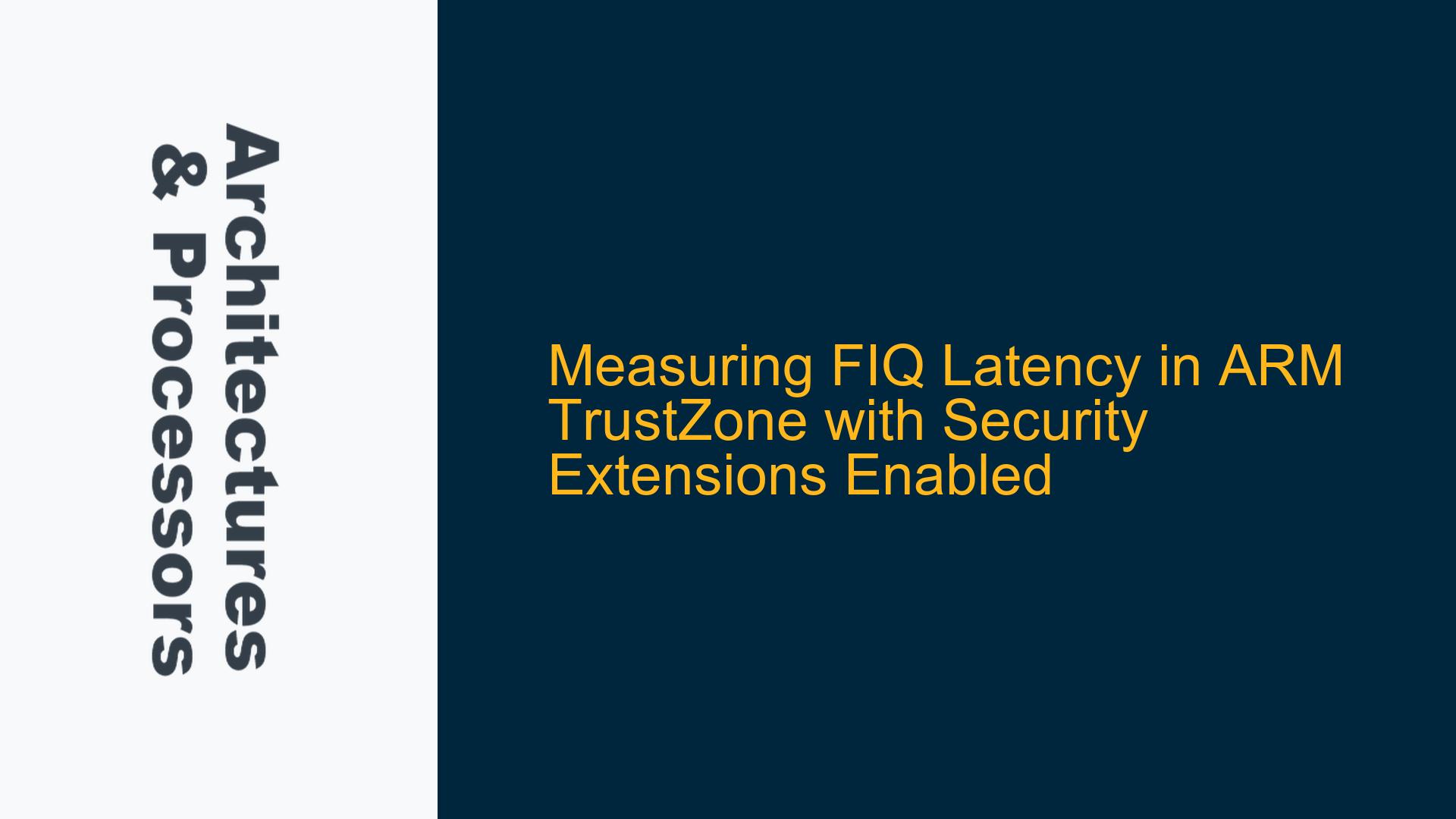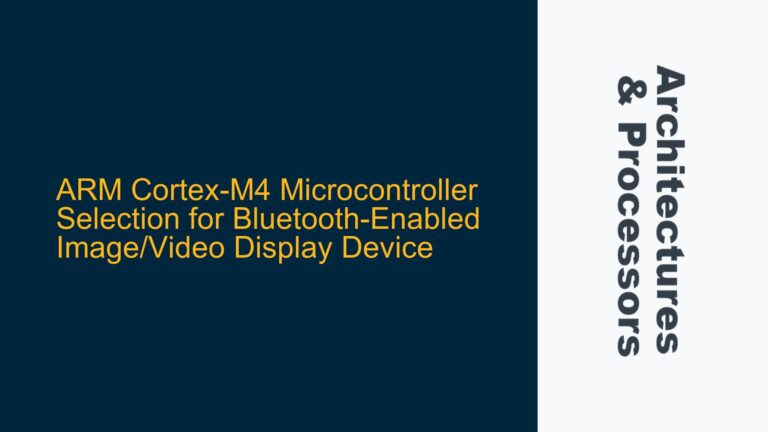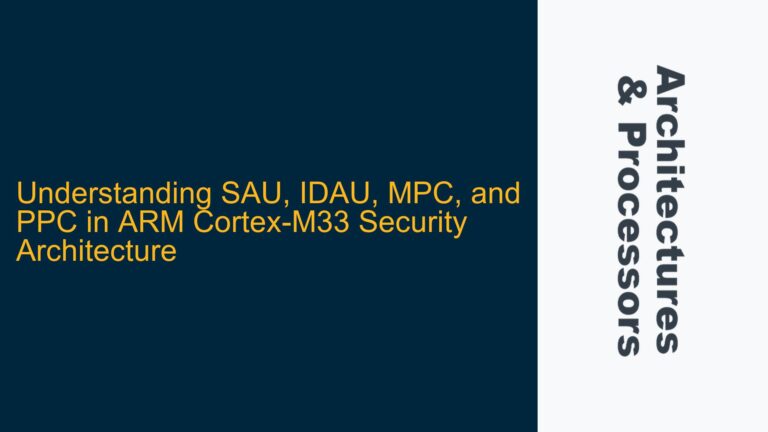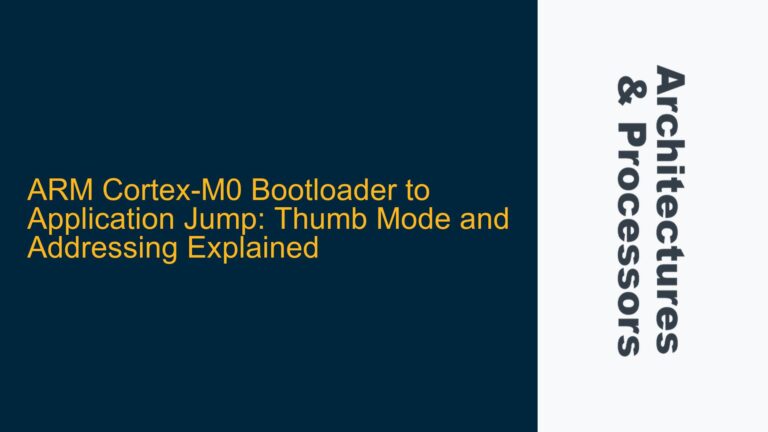FIQ Latency Measurement Challenges in ARM Cortex-A7 with TrustZone
When working with ARM Cortex-A7 processors that have TrustZone security extensions enabled, measuring Fast Interrupt Request (FIQ) latency can be particularly challenging. The primary issue revolves around determining whether an FIQ occurred while the General Purpose Operating System (GPOS) was executing or while the Real-Time Operating System (RTOS) was executing. This distinction is crucial for accurately measuring the latency of FIQs in different execution contexts, especially when the system transitions between secure and non-secure states.
The ARM Cortex-A7 processor, which is based on the ARMv7-A architecture, incorporates TrustZone technology to provide a secure execution environment. TrustZone divides the processor into two worlds: the secure world and the non-secure world. Each world has its own set of operating systems and applications, and the processor can switch between these worlds using the Secure Monitor Call (SMC) instruction. This switching mechanism introduces additional complexity when measuring FIQ latency, as the processor must save and restore the context of the current world before handling the FIQ.
In a typical TrustZone-based system, the RTOS runs in the secure world, while the GPOS runs in the non-secure world. When an FIQ occurs, the processor must determine which world was active at the time of the interrupt and then handle the interrupt accordingly. This process involves several steps, including context switching, saving and restoring registers, and potentially flushing caches, all of which contribute to the overall FIQ latency.
The challenge in measuring FIQ latency lies in accurately determining the execution context at the time of the interrupt. Specifically, it is necessary to identify whether the FIQ occurred while the GPOS was executing or while the RTOS was executing. This information is critical for understanding the performance implications of TrustZone security extensions and for optimizing the system to minimize FIQ latency.
Context Switching Overhead and Register Management in ARMv7-A
One of the primary factors contributing to FIQ latency in ARM Cortex-A7 processors with TrustZone enabled is the overhead associated with context switching between the secure and non-secure worlds. Context switching involves saving the current state of the processor, including the core registers, FPU/NEON registers, and other non-shadowed registers, before switching to the new context. This process is necessary to ensure that the state of the current world is preserved and can be restored after the FIQ has been handled.
The ARMv7-A architecture provides several mechanisms for managing context switching, including the use of banked registers and the Secure Monitor. Banked registers are duplicated for each world, allowing the processor to quickly switch between worlds without the need to save and restore all registers. However, not all registers are banked, and some registers must be explicitly saved and restored during context switching. This includes the general-purpose registers, the program counter (PC), the stack pointer (SP), and the link register (LR).
In addition to the core registers, the FPU/NEON registers must also be saved and restored during context switching. The FPU/NEON registers are used for floating-point and SIMD operations, and they are not banked between worlds. As a result, the processor must save the current state of these registers before switching to the new context and restore them after the FIQ has been handled. This process can add significant overhead to the context switching process, particularly if the system makes extensive use of floating-point or SIMD operations.
The Secure Monitor is responsible for managing the transition between the secure and non-secure worlds. When an FIQ occurs, the Secure Monitor must determine which world was active at the time of the interrupt and then switch to the appropriate world to handle the interrupt. This involves saving the current state of the processor, switching to the new world, and then restoring the state of the new world. The Secure Monitor must also ensure that the interrupt is handled in the correct world, which may involve additional checks and validations.
The overhead associated with context switching and register management can significantly impact FIQ latency, particularly in systems that frequently switch between the secure and non-secure worlds. To minimize this overhead, it is important to optimize the context switching process and reduce the number of registers that must be saved and restored. This can be achieved through careful design of the system software and by leveraging the banked registers provided by the ARMv7-A architecture.
Implementing Secure and Non-Secure World Interrupt Handling
To accurately measure FIQ latency in a TrustZone-based system, it is necessary to implement a mechanism for handling interrupts in both the secure and non-secure worlds. This involves configuring the interrupt controller to route FIQs to the appropriate world and ensuring that the interrupt handler can determine the execution context at the time of the interrupt.
In the ARM Cortex-A7 processor, the Generic Interrupt Controller (GIC) is responsible for managing interrupts and routing them to the appropriate world. The GIC can be configured to route FIQs to either the secure or non-secure world, depending on the system requirements. When an FIQ occurs, the GIC determines which world should handle the interrupt based on the configuration of the interrupt and the current state of the processor.
To measure FIQ latency, it is necessary to configure the GIC to route FIQs to both the secure and non-secure worlds and to implement interrupt handlers in both worlds. The interrupt handlers must be able to determine the execution context at the time of the interrupt and record the time at which the interrupt occurred. This information can then be used to calculate the FIQ latency for each execution context.
One approach to determining the execution context at the time of the interrupt is to use a combination of hardware and software mechanisms. For example, the processor can be configured to generate a software interrupt when an FIQ occurs, and the interrupt handler can use this information to determine the execution context. Alternatively, the interrupt handler can examine the state of the processor and the contents of certain registers to determine the execution context.
Once the execution context has been determined, the interrupt handler can record the time at which the interrupt occurred and calculate the FIQ latency. This can be done using a high-resolution timer or by reading the value of the processor’s cycle counter. The calculated latency can then be used to analyze the performance of the system and to identify any bottlenecks or areas for optimization.
In addition to measuring FIQ latency, it is also important to consider the impact of other factors on interrupt handling, such as cache management and memory barriers. The ARMv7-A architecture provides several mechanisms for managing caches and ensuring data coherency, including the Data Synchronization Barrier (DSB) and the Instruction Synchronization Barrier (ISB). These barriers can be used to ensure that the processor’s caches are flushed and that the interrupt handler has access to the most up-to-date data.
By carefully configuring the GIC, implementing interrupt handlers in both the secure and non-secure worlds, and using hardware and software mechanisms to determine the execution context, it is possible to accurately measure FIQ latency in a TrustZone-based system. This information can then be used to optimize the system and minimize the impact of TrustZone security extensions on FIQ latency.
Optimizing FIQ Latency in TrustZone-Based Systems
Optimizing FIQ latency in a TrustZone-based system requires a thorough understanding of the ARMv7-A architecture and the specific challenges associated with TrustZone security extensions. The goal is to minimize the overhead associated with context switching, register management, and interrupt handling while ensuring that the system remains secure and reliable.
One of the key strategies for optimizing FIQ latency is to reduce the number of context switches between the secure and non-secure worlds. This can be achieved by carefully designing the system software to minimize the frequency of world switches and by leveraging the banked registers provided by the ARMv7-A architecture. By reducing the number of context switches, the overhead associated with saving and restoring registers can be minimized, resulting in lower FIQ latency.
Another important strategy is to optimize the interrupt handling process. This involves configuring the GIC to route FIQs to the appropriate world and implementing efficient interrupt handlers that can quickly determine the execution context and record the time at which the interrupt occurred. The use of high-resolution timers and cycle counters can help to accurately measure FIQ latency and identify any bottlenecks in the interrupt handling process.
In addition to optimizing the context switching and interrupt handling processes, it is also important to consider the impact of cache management and memory barriers on FIQ latency. The ARMv7-A architecture provides several mechanisms for managing caches and ensuring data coherency, including the Data Synchronization Barrier (DSB) and the Instruction Synchronization Barrier (ISB). These barriers can be used to ensure that the processor’s caches are flushed and that the interrupt handler has access to the most up-to-date data. By carefully managing caches and using memory barriers where necessary, the impact of cache-related delays on FIQ latency can be minimized.
Finally, it is important to consider the impact of other system-level factors on FIQ latency, such as the design of the RTOS and GPOS, the configuration of the memory subsystem, and the overall system architecture. By carefully designing and optimizing these components, it is possible to create a system that delivers low FIQ latency while maintaining the security and reliability provided by TrustZone technology.
In conclusion, measuring and optimizing FIQ latency in a TrustZone-based system requires a comprehensive understanding of the ARMv7-A architecture and the specific challenges associated with TrustZone security extensions. By carefully designing the system software, optimizing the context switching and interrupt handling processes, and managing caches and memory barriers, it is possible to minimize FIQ latency and create a system that delivers high performance and security.






